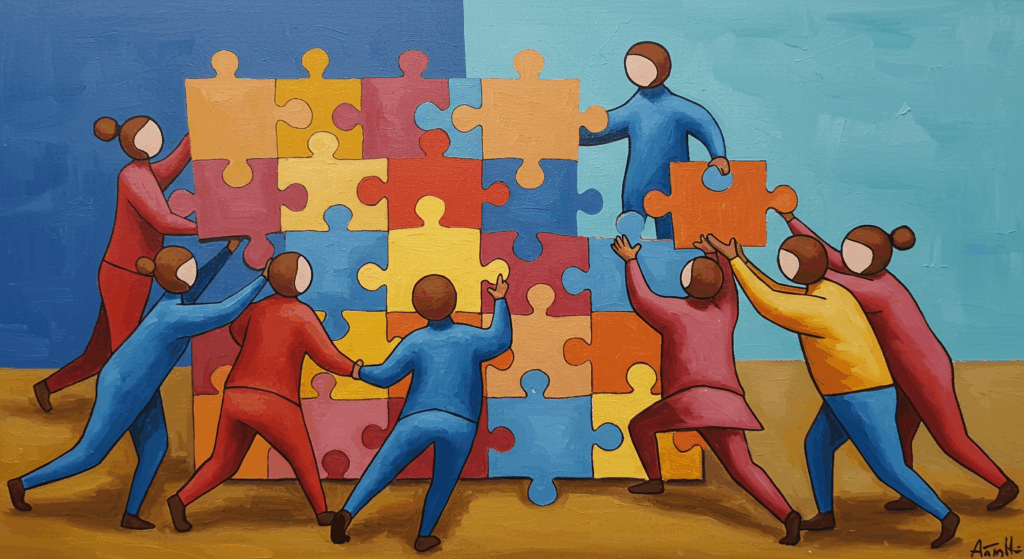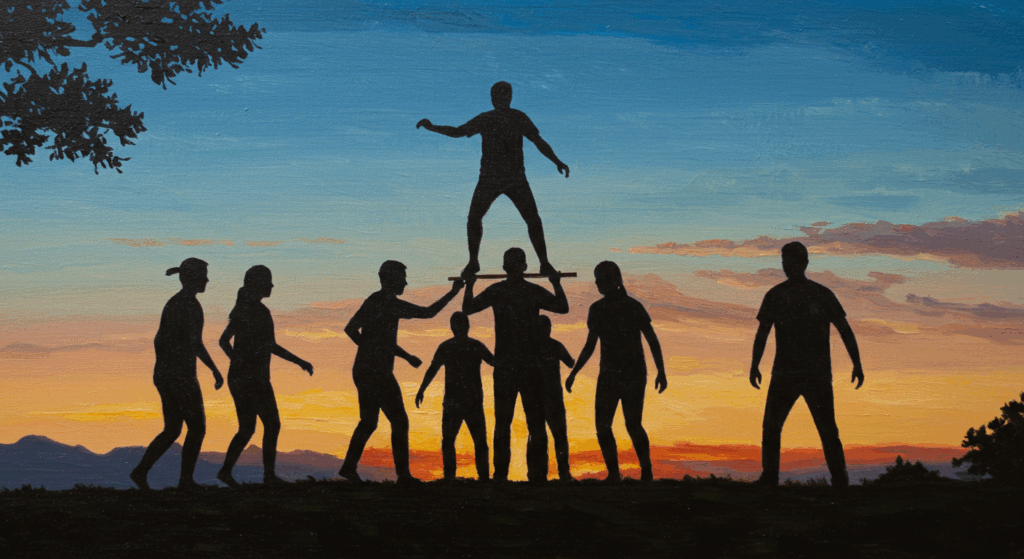If you’ve ever been dragged into an awkward icebreaker and felt your soul leave your body, hi—same. Team bonding has a reputation problem: too many trust falls, not enough trust; too many scavenger hunts, not enough real talk. But when it’s done with intention (and a little personality), team bonding quietly turns into fuel for better collaboration, smoother teamwork, and a feeling of connection that actually lasts beyond one calendar invite. Let’s build that version—the one that doesn’t feel cringe, forced, or corporate-y in the worst way.
What “Team Bonding” Actually Means (and why it matters more than we admit)
Team bonding isn’t just hanging out. It’s the ongoing practice of helping people feel safe, seen, and supported while doing meaningful work together. That safety is the foundation of collaboration; it unlocks honest feedback, good conflict (yes, there’s such a thing), and less CYA energy. When folks trust each other, they share context faster, ask for help sooner, and catch mistakes earlier. That’s teamwork doing its job.
And ngl, bonding is a productivity thing—just not in the hustle-bro way. When relationships are strong, you spend less time decoding tone and more time shipping. You default to curiosity over blame. You know who’s quietly amazing at data and whu can turn chaos into a checklist. That emotional map of your team? That’s connection.
The Mindset Shift: From “Forced Fun” to “Designed Connection”
“Hmmm, do we really need another game?” Maybe. But the point isn’t the game—it’s the structure that allows people to connect. So before you throw calendar blocks at the problem, think like a product designer:
- Make it voluntary-ish. Strong nudge, clear why, but no shame for bowing out. People have lives, sensory limits, time zones. Respect that.
- Small beats big. Big events are flashy; small rituals are sticky. Micro-moments compound over time.
- Blend work and play. The best bonding lives close to the work: pairing, reviews, retros, learning sessions. If it strengthens collaboration, it counts.
- Keep receipts. Not of pizza. Of impact. Track tiny metrics (participation, mood, cycle time, bug count) and see what changes.
The Core Ingredients of Bonding That Sticks
Think of this like a mini recipe for teamwork.
Psychological Safety (the base layer)
No one should fear asking “dumb” questions or surfacing bad news. Try: leaders going first with what they’re uncertain about; team norms that celebrate learning, not perfection; a retro culture that asks “What helped?” before “Who messed up?”
Shared Purpose (the seasoning)
People bond over meaning, not errands. Keep the mission visible. Tie a project to an actual user story. Start meetings with a 10-second reminder: “We’re doing X because it helps Y.”
Repeated Contact (the slow simmer)
You don’t speedrun connection. You build it through consistent, human touches. Rituals matter (more on those in a sec).
Utility + Joy (the garnish)
- If an activity is useful and a little fun, it wins.
- If it’s only fun, it fades.
- If it’s only useful, it drains.
Everyday Rituals That Build Collaboration Without Feeling Extra
You do not need a yacht. You need 15–45 minute blocks that make the work easier and the vibe better.
The One-Word Check-In
At the start of standup: “One word for how you’re arriving.” Fast, inclusive, less pressure than oversharing. It builds connection while keeping momentum.
Win, Blocker, Ask
Everyone shares one quick win, one blocker, one clear ask. This normalizes updates and reduces Slack-spirals. Over time, the team gets braver about naming issues (which is low-key the whole point of teamwork).
Pair Hours (a.k.a. “We Do This Together”)
Put two people in a call for 25–50 minutes, cameras optional, shared screen on. Rotate pairs weekly. It spreads knowledge and kills the “single expert” risk. Also: it’s sneaky bonding.
Demo Fridays (15 minutes, tops)
Two micro-demos: “Here’s something I built” and “Here’s something I learned.” Keep applause quick and kind. It rewards curiosity and makes collaboration public—not just private DMs.
Ask Me Anything (but make it scoped)
Once a month, a teammate hosts a 20-minute AMA on a topic they love: performance profiling, inclusive copy, Notion wizardry, whatever. It’s bite-size learning with built-in connection.
Gratitude Thread (async)
Friday thread: “Tag someone and thank them for a specific moment this week.” Specific is key. “They saved my Tuesday by x.” This builds a written record of care. Also doubles as receipts for performance reviews (just sayin’).
Remote and Hybrid Reality: Bonding Without the Office
We’re not going back to free-snack culture (sorry, LaCroix). Good news: remote bonding can be better because it’s more intentional.
Time Zone-Friendly Touches
- Rotate meeting times quarterly so the same people aren’t always sacrificing.
- Keep events <45 minutes and record anything possible.
- Offer async alternatives (threads, Looms) so connectiom isn’t a scheduling tax.
Zero-Pressure Socials
- Drop-in coworking rooms: same Zoom link, no agenda, join if you want company.
- Coffee roulette: opt-in bot pairs you for 15 minutes. Make it “bring a meme” to break the ice.
- Show-and-tell: everyone shares a non-work item on camera—plants, pets, a weird mug. Low stakes, high smiles.
Async Props Wall
A dedicated channel for shout-outs and mini wins. Pin a simple template: “What happened → why it mattered → who helped.” This keeps collaboration and connection visible when you can’t literally see anyone.
Activities That Don’t Suck (I promise)
No offense to trust falls, but… no.
The “Fix a Paper Cut” Sprint
Pick small annoyances (broken scripts, janky templates, confusing docs). Block one afternoon to fix as many as possible, then demo. It’s bonding through shared relief.
Lightning Learning Fair
Everyone gets 5 minutes to share something delightful: a shortcut, a customer insight, a keyboard trick, a mini-case study. Fast, energizing, and it makes hidden expertise visible.
Creative “Yes, And” Challenge
In groups of 3–4, build something silly in 30 minutes: a FAQ for aliens using your product; a fake billboard; a one-page pitch deck for a bizarre feature. Rules: say “yes, and,” ship something tiny, share it. This trains collaborative improv muscles—very useful for brainstorming and conflict.
Customer Call Club
Volunteer crew listens to one customer interview monthly (recording or live). People drop 2–3 insights in a shared doc. It’s empathy practice that bonds the team to real humans.
“Undo the Meeting” Hackathon
Take a recurring meeting everyone secretly dreads and replace it with a lightweight system (doc + async comments + rotating DRI). Celebrate the reclaimed time with a 20-minute game of Gartic Phone or Skribbl—but only after you ship the fix.
Collaboration That Actually Works (without the drama)
You want bonding to make teamwork cleaner, not messier.
Clarity Before Chemistry
Connection is easier when roles and goals are clear. Do a quick RACI (who’s Responsible, Accountable, Consulted, Informed) on major projects. Make owners publicly visible, not mysterious.
“Two Truths and a Trigger”
Instead of the classic party game, try a work version. Each person shares two things that help them collaborate (e.g., “visuals help me understand”) and one trigger (“last-minute scope changes stress me out”). It’s a playful way to collect user manuals for each teammate.
Decision Logs (super simple)
A lightweight doc with three columns: Decision, Why, Owner. Scan weekly. This prevents déjà vu debates and reduces political vibes. Connection thrives when memory is external, not tribal.
Feedback With Guardrails
Adopt a shared feedback script. Example: “I noticed X, I felt Y, I wonder Z, I suggest W.” Practice it. Role-play it. Yes it feels dorky for 10 minutes; then it makes your whole quarter calmer.
Inclusion Is Not Optional (and yes, it’s bonding)
If bonding excludes people, it’s not bonding.
Accessibility First
- Offer camera-optional events.
- Share agendas and materials ahead for neurodiverse teammates.
- Provide captions/transcripts when possible.
- Keep sensory load in mind (music, visual clutter, busy Zoom backgrounds).
Cultural + Personal Respect
Not everyone drinks alcohol, wants to dance, or loves loud spaces. Plan alternatives. Offer choices (crafting session or board games or tea tasting). Inclusion is basically optionality.
Don’t Make Everything After Hours
People have kids, caregiving, commutes. Try lunch-hour sessions or mid-day blocks. Recordables > mandatories.
Conflict to Connection: Repair as a Team Habit
Bonding isn’t the opposite of conflict. It’s your insurance policy for getting through it.
The “We Got Spicy” Debrief
When a meeting goes sideways, someone says: “We got spicy. Let’s do a 10-minute reset.” Ask:
- What did each person hear?
- What matters most here?
- What do we need next?
Short, structured, heals a lot.
Retro Prompts That Actually Surface Stuff
Rotate prompts like:
- “What energized you this sprint?”
- “Where did we duplicate effort?”
- “Where did we hide confusion under ‘it’s fine’?”
Make one repair commitment per retro. Keep it small and real.
Onboarding: Bond Fast, Not Fake
First 30–60 days set the tone. New people don’t need swag bags; they need context and people.
A Buddy + A Map
Assign a buddy (not their manager) and a “first week map”: where to find docs, what to ignore, who to meet. Include a “say hello” checklist with 5–7 quick chats. That’s lightweight, high-value connection.
“Day 10 Share”
Ask new folks to present “What surprised me so far” in 5 minutes. It’s friendly reverse-mentorship and invites authentic colllaboration.
Budget-Friendly Bonding (because not every company is a tech unicorn)
- Walk + talk 1:1s: audio-only, outside if possible. Free and good for brains.
- Screenshot museum: a Notion/Drive folder of “cool design we saw” or “customer quotes we love.”
- Office hours: rotating open rooms where anyone can drop by and ask for help.
- 30-minute soundtrack swap: share a focus playlist; listen together while co-working. (If someone says “lofi,” we nod respectfully.)
Offsites, Onsites, and When to Go Big
Big moments are worth it—if you earn them.
Make Big Moments Work Harder
- Purpose first: are we solving cross-team friction, kicking off a product, or celebrating a milestone?
- Mix your formats: short talks, long breaks, hands-on workshops, free time. Don’t over-schedule.
- Capture artifacts: photos (consent!), whiteboard scans, decisions doc, a short recap video. Keep the connection alive after the plane ride home.
Don’t Overdo “Mandatory Fun”
One or two high-energy events per offsite is plenty. Leave room for quiet bonding: breakfast tables, mini walks, small group dinners. Connection happens in the margins.
Manager Moves That Multiply Connection
Leaders, you’re the weather. Your choices set the climate for collaboration.
Ask Better Questions
- “What’s something we should stop doing this month?”
- “Where are we over-engineering?”
- “Whose work isn’t visible but deserves credit?”
Then, do something with the answers.
Normalize Boundaries
Say out loud that you’ll be offline at 6. Encourage status updates to include “no response needed.” Connection improves when people are not pretending to be 24/7.
Share Your Working Manual
Publish your preferences: how you like updates, your “tell me early” topics, your blindspots. Model the vulnerability you want from the team.
Measuring the ROI (light touch, don’t turn this into homework)
You don’t need a 40-question survey. Keep it tight and consistent.
- Participation: are people showing up or skipping? Look for trends, not perfection.
- Pulse sentiment: monthly 2-question poll—“I feel connected to my team,” “I can ask for help without stress.” 1–5 scale.
- Ops indicators: lead time, bug count, incident recovery time, PR review speed. If collaboration is improving, these often quietly improve too.
- Turnover and referral rates: connected teams keep people and attract friends.
Track for a quarter. Adjust. Celebrate little wins.
Guardrails: How to Avoid the Cringe
Let’s be honest about the traps.
- Activity over intention: Don’t run an event because the calendar is empty. Start with the why.
- Inside jokes: Fun, but watch for cliques. Rotate partners, keep language inclusive.
- Over-reliance on “funny people”: Not everyone is a natural MC. Share the mic or keep formats simple.
- Privacy fails: Never pressure personal disclosures. “Pass” is always allowed.
- Boredom: Shorten it. Energy is a gift—don’t waste it.
A Simple Quarterly Plan (that actually fits reality)
Here’s a low-maintenance rhythm you can copy-paste and tweak.
Monthly
- Week 1: 30-minute retro with one repair commitment.
- Week 2: 20-minute Lightning Learning.
- .Week 3: Pair Hour rotation + gratitude thread.
- Week 4: Demo Friday (two demos, 7 minutes each), optional coffee roulette.
Quarterly
- Team health check: the 2-question pulse plus one open question.
- Mini paper-cut sprint: half-day to kill annoyances.
- AMA + social: AMA tied to a project milestone; keep the social optional.
This cadence respects time while steadily building connection. It’s teamwork as a practice, not a party trick.
Micro-Scripts You Can Use Tomorrow
Sometimes you just need words. Steal these.
- Kickoff: “Goal for today: make collaboration easier and leave with one tiny improvement. Cameras optional. Participation optional. Respect guaranteed.”
- Invite: “Join if this helps you; skip if it doesn’t. We’ll share notes either way.”
- Conflict reset: “We’re heated. Let’s do a 10-minute ‘what I heard / what I need next’ loop.”
- Recognition: “Shouting out @Name for [specific action]. It saved us [cost/time/energy] and helped [person/team].”
- Boundary: “I’m logging off, replies tomorrow. If urgent, use the 🔴 tag.”
For New Managers: Start Small, Earn the Big Stuff
If you’re new to this, you don’t need to invent the perfect bonding program. Pick two rituals and run them consistently for eight weeks. Keep them short, keep them kind, and measure something. When people start referencing those rituals like they’ve always existed, you’ll know you’ve planted roots.
For ICs: You Don’t Need Permission to Build Connection
Honestly, some of the best bonding is grassroots. Start a five-person study group. Host a 15-minute “shortcuts” demo. Create the props wall. Influence is a team sport; you already have enough to start.
Bringing It All Together: Collaboration, Teamwork, Connection (in real life)
Here’s the vibe: collaboration is the engine, teamwork is the vehicle, and connection is the fuel. Without the fuel, the whole thing sputters. With it, your team moves like a single organism—quick to adapt, generous with context, allergic to drama. Not perfect (lol, we’re human), but resilient and a little bit joyful.
The best part? You don’t have to overhaul everything. Choose one ritual, one activity, and one repair habit. Run them lightly, consistently, with empathy. Watch how the group starts to relax. People laugh more. They raise their hands sooner. They ping each other less because they plan better. So, they quietly build the kind of trust that makes the work feel… surprisingly good.
Quick Start (because you might want a checklist)
- Add a One-Word Check-In to standups this week.
- Schedule a Pair Hour rotation for next sprint.
- Launch a Friday Gratitude Thread (keep it specific).
- Plan a Lightning Learning in two weeks (5 minutes per person).
- Do a mini retro monthly with one repair commitment.
That’s it. Five moves. Zero cringe. Max respect for everyone’s time and brain cells. Over a quarter, you’ll see the compounding effect—more momentum, fewer misunderstandings, and a team that feels like a team, not a collection of calendar squares.
Alright, your turn. Pick one idea and try it this week. If it helps even a little, celebrate that win and do it again. You’ve got this—build the connection you want to work in, and let the collaboration and teamwork follow.









